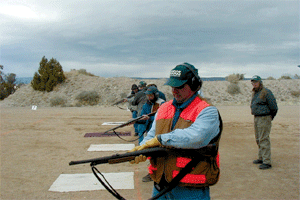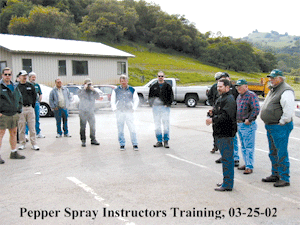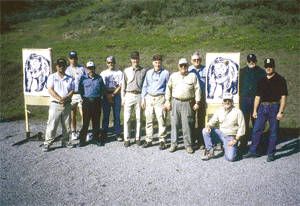April 2005
Obtaining Firearms Authorization
Storage, Security, and Transport
USGS Firearms Instructor Course for Defense Against Wild Animals, Santa Cla...
The U.S. Geological Survey provides appropriate firearms safety training for any employee or USGS volunteer who uses, handles, carries, or stores a firearm as a part of his or her official duties. Firearms are used by USGS employees for defense against potentially dangerous wild animals and for specimen collecting for biological research. Firearms may also be used for signaling and survival in emergency situations.
In 1978, the USGS developed firearms safety training for defense against wild animals following a near-fatal attack on a USGS geologist during the 1977 field season in Alaska. The firearms safety training for personnel involved in specimen collection (biological research) was developed after the National Biological Service was integrated into the USGS as the Biological Resource Discipline (BRD) in 1997.
Although firearms safety remains a constant emphasis and is a key element of any firearms safety training program, there are substantial differences in the two programs. In the USGS Defense Against Wild Animals (DAWA) training program, firearms are restricted to those action and model types that can handle powerful, large-caliber cartridges. The firearm is a tool of last resort and is only used when other deterrents are exhausted or impractical. The Specimen Collection (SC) training program deals with a broad range of firearm types, from rimfire to large-bore calibers, and includes almost every type of firearm action, make, and model.
 (click on image for larger version)
(click on image for larger version)
USGS firearms policy and training methodology have continually improved since the tragic incident in 1977. Current doctrines are the result of extensive field experience by USGS personnel, and many of the training concepts have been adapted from professional firearms training schools. Both the DAWA and the SC firearms training programs are constantly changing as new information from actual field experiences is incorporated into the curriculum and firearms training techniques from other professional training programs are reviewed and tested.
A number of more specialized USGS Firearms Safety curriculums are being developed to better address USGS training needs. In addition to the DAWA program, separate curriculums and courses are being developed that include Wild Animal (Bear, Cougar, etc.) Behavior, Bear Pepper Spray and Other Less-lethal Deterrents for Wild Animals, Collection of Waterfowl, Precision Shooting, and Small-Caliber Firearms for Trapping. Others will be added as needed.
These curriculums will have specific instructor certifications, and USGS personnel and managers will soon be able to choose which type(s) of training will best satisfy their science program needs.
 (click on image for larger version)
(click on image for larger version)
With supervisory permission, any employee or volunteer can be authorized to carry a firearm while on official duty once he or she has completed the following requirements, as specified in Chapter 29 of the Occupational Safety and Health Program Requirements Handbook, SM 445-2-H. These include:
 (click on image for larger version)
(click on image for larger version)
USGS Firearms Instructor Course for Defense Against Wild Animals, Santa Clara, CA, 2002.
USGS Firearms Instructors must be able to independently and effectively teach the fundamentals of firearms safety and safe firearms handling. Instructor certification requires approximately 150 hours of formal training including a USGS Firearms Instructor Class and apprenticing as an assistant instructor. Detailed requirements for USGS firearms instructorship are listed in SM-445-H, Ch. 29.3, part D, Firearms Instructors, http://www.usgs.gov/usgs-manual/handbook/hb/445-2-h/ch29.html.
Details for firearms storage, security, and transport are found in section 29.5 of the USGS Physical Security Handbook at http://www.usgs.gov/usgs-manual/handbook/hb/440-2-h.html.
Both Bureau and regional management personnel oversee the USGS Firearms Safety Program. For further information on USGS firearms regulations, policies, and training, contact the appropriate person(s) as follows:
BUREAU
Charles D. Blome Denver, CO
Firearms Program Manager 303-236-1278
cblome@usgs.gov
EASTERN REGION
Wayne E. Martin Reston, VA
Eastern Region Firearms Manager 703-648-5289
wmartin@usgs.gov
CENTRAL REGION
Mary E. Cast Denver, CO
Central Region Firearms Manager 303-236-3463
mecast@usgs.gov
WESTERN REGION (except Alaska)
W. Karl Gross Menlo Park, CA
Western Region Firearms Manager 650-329-4845
kgross@usgs.gov
ALASKA REGION
Vacant
Document Accessibility: Adobe Systems Incorporated has information about PDFs and the visually impaired. This information provides tools to help make PDF files accessible. These tools convert Adobe PDF documents into HTML or ASCII text, which then can be read by a number of common screen-reading programs that synthesize text as audible speech. In addition, an accessible version of Acrobat Reader 6.0, which contains support for screen readers, is available. These tools and the accessible reader may be obtained free from Adobe at Adobe Access.
| AccessibilityFOIAPrivacyPolicies and Notices | |
| |
|